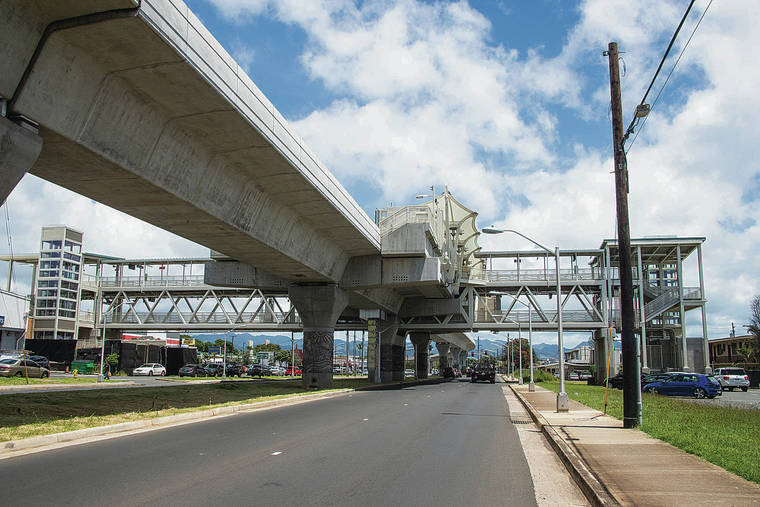The trains built for Honolulu’s troubled rail project have wheels that are too narrow for the track, and solving the problem will lead to more issues or more delays.
Replacing the wheels will add too much weight to the trains. Replacing the tracks would push the timeline back a year.
Like many aspects of the rail project, there is no easy solution ahead.
Lori Kahikina, interim CEO and executive director of the Honolulu Authority for Rapid Transportation, told HART’s Project Oversight Committee on Thursday that the wheels are about a half-inch too narrow at the “frogs,” the places where rail tracks cross.
One option would be to replace the wheels with wider ones. But Kahikina said thicker wheels would make the trains overweight.
Replacing the tracks with narrower ones would set the project back at least a year, Kahikina told HART board member Kika Bukoski.
“One solution that is being contemplated right now is maybe changing the wheels on all of the cars,” Kahikina said. “It’s a faster solution and a cheaper solution, but one drawback to changing the wheels is that you’re adding weight to the cars, and so they’re going to go over the threshold. So you have to subtract weight somewhere. … If you have to change the track, that’s estimated to be maybe one year just to manufacture the new track and ship it over here, whereas the wheels could be much quicker. I’m sorry. I don’t have a good answer, Kika, just because the solution hasn’t been determined yet.”
Asked whether the wheel problem will delay turning rail operations over to the city, Kahikina told Bukoksi, “This solution will delay that.”
The too-thin wheels are in addition to other problems at the frogs, including subpar welding and sandblasting that created cracks.
The 20-mile, 21-station project is now budgeted to cost $12.449 billion, is not scheduled for completion until March 2031 and has no easy away to plug a $3.577 billion shortfall.
Kahikina said rail officials and Mayor Rick Blangiardi are expecting to present federal officials with a plan in the next few months outlining how to build rail all the way to Ala Moana Center and make up for the budget shortfall.
But Kahikina did not rule out the possibility of halting construction “somewhere in downtown.”
Bukoski asked Kahikina whether the issue of stopping rail at Middle Street — 4 miles shy of its Ala Moana Center final destination — came up during a quarterly meeting with the Federal Transit Administration this week that included Blangiardi.
Kahikina responded that Blangiardi is aware of the funding gap, but made no mention to the FTA about stopping short of Ala Moana Center, the state’s busiest transit hub.
Sometime around July or August, the city expects to return to the FTA “with a plan on how we’re going to get there,” Kahikina said. “Mayor is committed to getting all the way to Ala Moana Shopping Center.”
In the meantime there is hope that general excise and transit accommodation taxes, which were crippled during the COVID-19 pandemic and the shutdown of tourism, will return “higher than expected” and provide needed revenue, Kahikina said.
“Middle Street is not going to work,” she said. “If we could get somewhere in downtown, I don’t know, we’d have to look at that. We’d have to look at the different scenarios, and then HART is trying to put together a plan in conjunction with the mayor and then talk about this. And once we have a plan going forward, myself and mayor will go to FTA and speak to them about it.”
The question of stopping construction at Middle Street continued to hover over HART on Thursday.
Board member Roger Morton, who used to oversee the city’s TheBus system, said, “After spending billions of dollars to get where we’re at … Middle Street is not as good. … We still have that tremendous traffic congestion. … There’s no good way to get into town.”
Board member Joe Uno, who has been urging the board to discuss an unspecified “Plan C” for the future of rail, pushed back.
“I don’t feel it’s (stopping at
Middle Street) been studied as a stand-alone alternative,” Uno said. “Certain options probably have not been discussed or even thrown up on the table — things like having express buses run in express lanes and that type of thing.
“I think we should be prepared … and keep an open mind if it does come down that we’re requested to study those a little bit more in depth,” Uno said.

